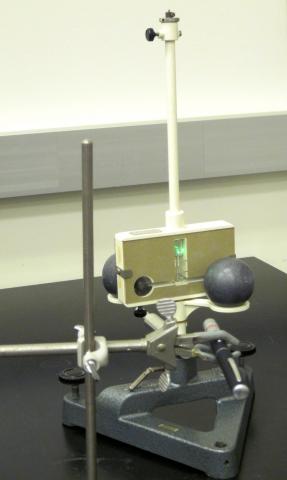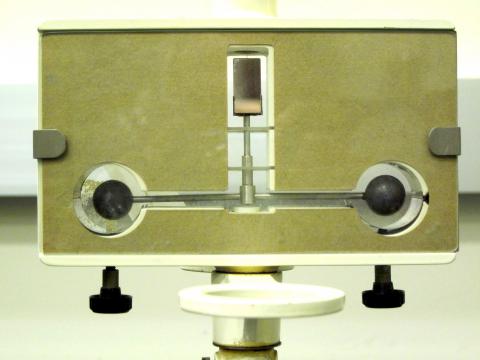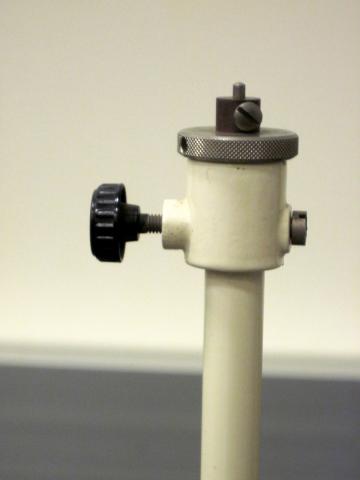Cavendish Gravitation Balance
NOTE: This experiment is part of P391 Junior Lab and may be in use. Check with the P391 instructor before requesting the demonstration.
The gravitation torsion balance according to Cavendish is a light transverse beam, horizontally suspended by a thin torsion fiber, which supports a small lead ball with the mass m2 at each end at a distance d from the suspension point. These two balls are attracted by two large lead spheres with the mass m1. Although the force of attraction is less than 10–9 N, it is still possible to demonstrate this using the extremely sensitive gravitation torsion balance. The motion of the small lead balls is observed and measured using a light beam pointer. This light pointer is generated using a lasser pointer and an illuminated concave mirror which is mounted in a fixed position on the transverse beam of the torsion pendulum. On the basis of the motion over time, the mass m1 and the geometry of the setup, it is possible to determine the gravitational constant.
NOTE: This demonstration is very qualitative. Performing the actual experiment requires careful set up and a long time.
1. Place the balance on the table. Release the torsion fiber suspension by 1) Turn the thumbscrews on the bottom of the chamber to release the clamping plate, and 2) loosen the side thumbscrew on the side of the top of the fiber suspension, press down on the top of the rod, and while holding the rod down, re-tighten the thumbscrew. The transverse beam with the two small lead balls should now rotate freely.
2. Position the laser pointer in its stand and aim it at the center of the mirror so that the reflected beam points on a wall or whiteboard where it can be monitored by the class. Observe safety precautions for the reflected beam.
3. Place the large lead balls carefully on the pedestal, swing the pedestal to one side until a large lead ball gently touches the plastic window.
4. Wait for the mirror to settle down, note the position of the light pointer, and swing the pedestal to the other side until a large lead ball gently touches the plastic window.
5. When the mirror again settles down, not the new position of the light pointer.
6. If you really want to try calculating G, consult the linked papers below.
7. Before removing the apparatus, lock the fiber suspension by 1) Loosen the side thumbscrew on the side of the top of the fiber suspension to release the fiber and then re-tighten the thumbscrew, and 2) Turn the thumbscrews on the bottom of the chamber to tighten the clamping plate against the transverse beam.
More Information



